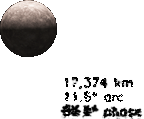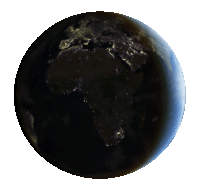

CURRENT LUNAR ORBITAL POSITION, PHASE & DISTANCE
Image Credits: NASA/JPL Solar System Simulator developed by: David Seal. (To update, reload page.)
L O A D I N G 


Phase We See
From Earth

Moon Distances (in Earth equatorial diameters):
Min Perigee = 27.9, Average Distance = 30.1, Max Apogee = 31.9
It is the Moon's orbital position (around Earth and relative to the Sun) that determines the lunar phase we see from Earth. ![]() The views above reveal the current circumstances of this fundamental relationship, as well as the cur- rent Earth-Moon center-to-center distance in Earth equatorial diameters. The wide "overhead" view of the Moon shows enough of the lunar orbit (slightly curved grey line) to infer the Moon's current position in its orbit around Earth, while the smaller view in the lower right corner shows the current Phase We See From Earth and links to ad- ditional lunar info. To further study this relationship interactively, check out these excellent simulations: #1 #2.
The views above reveal the current circumstances of this fundamental relationship, as well as the cur- rent Earth-Moon center-to-center distance in Earth equatorial diameters. The wide "overhead" view of the Moon shows enough of the lunar orbit (slightly curved grey line) to infer the Moon's current position in its orbit around Earth, while the smaller view in the lower right corner shows the current Phase We See From Earth and links to ad- ditional lunar info. To further study this relationship interactively, check out these excellent simulations: #1 #2.
Note that our wide overhead view always shows the Moon from above its North Pole and sunlight coming from the 12 o'clock direction (i.e. "upward" on your screen). So let's imagine the lunar orbit as the outer edge of a twelve-hour clock. Since the Moon—when viewed from "above" its orbit—moves around Earth in a counter-clockwise di- rection, then the Moon's orbital position is related to the lunar "Phase We See From Earth" as follows:
Moon at 12 o'clock high: NEW MOON not visible
Moon betw. 9 & 12 o'clock: WAXING CRESCENT ![]()
Moon at 9 o'clock: 1ST QUARTER MOON ![]()
Moon betw. 6 & 9 o'clock: WAXING GIBBOUS ![]()
Moon at 6 o'clock: FULL MOON ![]()
Moon betw. 3 & 6 o'clock: WANING GIBBOUS ![]()
Moon at 3 o'clock: LAST QUARTER MOON ![]()
Moon betw. 12 & 3 o'clock: WANING CRESCENT ![]()


QUICK VIEW OF 2025
MOON PHASES & ECLIPSES (UTC)
SOLAR: P = Partial LUNAR: T = Total
Click on months for Phases and Eclipses
The Quick View of 2023 Moon Phases & Eclipses (directly above) will verify the lunar phase on any day of the current year. Its dates are based on UTC (Coordinated Universal Time), which is essentially equivalent to GMT (Greenwich Mean Time). This 2025 Phases of the Moon List gives the time of each major phase.
For more advanced information on the current lunar phase, you can also visit Current Moon Phase & Libration or use the awesome online app Moon Phaser. And, of course, for more general information on the Moon's current circumstances you can always check out the Moon Viewed from Earth, as well as the Moon's Current Location in the Constellations. And for further intriguing insights into the complex lunar orbit—like the variability of the Moon's monthly perigees and apogees—be sure to check out the Current Apparent Sizes of the Sun & Moon.
Near the top of this page, in the "overhead" view of the Moon, you will discover that—at New Moon and Full Moon—the line of the lunar orbit will appear basically horizontal, bowing slightly upward and downward at their respective times. At 1st Quarter and Last Quarter the line of the lunar orbit will appear basically vertical, bowing slightly to the left and right respectively. In addition, when the Moon is very near 1st Quarter and Last Quarter, it will be seen crossing Earth's orbit, the nearly horizontal light-blue line that comes into view close to the times of these phases. However, most often the line of Earth's orbit will not appear strictly horizontal, as the view from above the Moon is from directly over its North Pole, and the lunar axis and the lunar orbit are both tilted relative to the Ecliptic.
Moon's Current
Position Over Earth
As you might expect, the lunar phase we see in our sky is also directly related to the Moon's current position over Earth. What matters is not the "geography" cur- rently below the Moon, but the point relative to daylight or darkness on Earth! The phase we see depends on when the Moon is directly over our planet as follows:
FULL & GIBBOUS MOONS: when Moon is over Earth's dark half;
QUARTER MOONS: when Moon is nearly over Earth's terminator;
NEW & CRESCENT MOONS: when Moon is over Earth's sunlit half;
(all, of course, subject to the Effects of Twilight).
The image (directly below) of Earth's and the Moon's partial paths around the Sun shows the lunar position over our planet during the various phases. Incidentally, the view (at right) of the Moon's Current Position Over Earth can also be thought of as a view of Earth "from the Moon". So if astronauts were on the Moon right now, to them our planet would be exhibiting a phase that—in terms of the proportion visible in sunlight—is the complement of the lunar phase that we currently see from Earth!
The scrollable image just below confirms that the Moon is near First or Last Quarter when it crosses Earth's orbit. In this image—as in the "overhead" view of the Moon at the top of this page—the Sun is in the 12 o'clock direction (i.e. "upward" on your screen). Yet, compared to the view near the top, the view directly below is greatly zoomed out to show a bit more than 1/12 (one twelfth) of the paths of Earth and the Moon around the Sun. Though the sizes of Earth and the Moon are quite exaggerated in this view, it clearly shows the circumstances that create the Moon's major phases. As you scroll the image you will find that, relative to Earth and its motion around the Sun, . . .
FULL & GIBBOUS MOONS occur "outside" of Earth's orbit,
LAST QUARTER MOONS occur "in front of" Earth,
NEW & CRESCENT MOONS occur "inside" of Earth's orbit,
FIRST QUARTER MOONS occur "behind" Earth.
EARTH'S AND THE MOON'S PATHS AROUND THE SUN
The view below gives another perspective on the Moon's current circumstances. Showing Earth, the Moon and the lunar orbit in their proper relative scale, its vantage point is "from the Sun". This means that, in the image below, when the Moon is at the far right and left of the lunar orbit respectively, First and Last Quarter phases are seen from Earth. At all other times the "Phase We See from Earth" clarifies the Moon's position and motion as follows.
When it "looks more than half illuminated" ![]()
![]()
![]() from Earth, the Moon must be in the half of its orbit
from Earth, the Moon must be in the half of its orbit
"farthest" from the Sun and moving from First to Last Quarter, right to left ( ![]() ) in our "View from the Sun".
) in our "View from the Sun".
When it "looks less than half illuminated" ![]()
![]()
![]() from Earth, the Moon must be in the half of its orbit
from Earth, the Moon must be in the half of its orbit
"nearest" to the Sun and moving from Last to First Quarter, left to right ( ![]() ) in our "View from the Sun".
) in our "View from the Sun".
VIEW FROM THE SUN FOV: 20' (arc-min) Magnification: 90x Open Interactive View
L O A D I N G 
Phase We See
From Earth
![]()
Moreover, showing the current orientation of the lunar orbit, our "View From The Sun" also shows whether—and by how much—the Moon is currently above or below Earth's orbital plane, the Ecliptic. It will also reveal when the Moon moves up and down through the Ecliptic at the lunar orbit's ascending and descending nodes respectively! This Sky Events Almanac from the excellent AstroPixels.com site gives the times of the Moon's nodal passages, as well as the times of lunar phases, and our View from the Sun: Interactive View lets you examine them more closely. The Moon's passages through its orbit's nodes become particularly important near the times of eclipses. Viewed from the Sun, as eclipse seasons approach, the oval of the lunar orbit appears to become thinner and thinner, eventually resolving into a line with a tilt of 5.145° (the tilt of the lunar orbit relative to the Ecliptic). At such times, the Moon's orbital plane is being seen "edge-on", and the lunar orbit's Line of Nodes is pointing essentially toward the Sun. It doesn't stay that way for long. From the vantage point of the Sun, the shape of the lunar orbit appears to change constantly, as Earth proceeds in its own orbit and "drags" the Moon along with it. This is why you will see the lunar orbit "wobble" around Earth over the course of a year. In addition, perturbed by other factors that add "less frequent wobbles", the Moon's path itself is highly complex and irregular!
As a bonus, check out this awesome, interactive 3-D Moon in Orbit, powered by the "NASA Eyes" online app. Here you'll see it open to reveal the current circumstances of the Moon in its orbit—as viewed from the "direction" of the Sun. In this case the view opens from a vantage point in close proximity to the Moon, though this distance may be increased or decreased as desired. (Note: you can halt the initial rotation by clicking anywhere in the blackness of deep space.) NASA's excellent app offers many other intuitive features as well. Its views may be panned left, right, up and down, showing the current lunar conditions in relation to the entire Solar System!
So there you have it! Now you have various ways to visualize the current circumstances of the Moon, and the means to easily and continually "keep tabs" on it as it orbits Earth! Tracking our nearest celestial neighbor in its monthly circuit around our home planet can be enlightening and great fun!
Notes: Phase views generated by NASA SVS Phase and Libration tool.
NASA/JPL Simulator Notes: 1) Field of View is measured horizontally. 2) Eclipse shadows are not displayed.
Home Intro News Gallery Sky-Gifts Bonuses Tips
Learning Ctr Help Links Credits Legal Contact Us
© 2007-
by Gary M. Winter. All rights reserved.
Interested in political cartoons and humor?
Check out The HIPPLOMATS™.
SkyMarvels, Sky Marvels, SkyMarvels.com, MOON Current Position in Phase Cycle, LUNAR ORBIT: VIEW FROM THE SUN (interactive), View for any day of the year! CURRENT VIEW OF THE MOON'S ORBIT FROM THE SUN, Moon's Orbit, Lunar Orbit, Moon's Phase, Lunar Phase, New Moon, Waxing Crescent, First Quarter Moon, Waxing Gibbous, Full Moon, Waning Gibbous, Last Quarter, Waning Crescent., Where the Moon Currently Is in its Orbit Around Earth, celestiaforall, CELESTIA, astronomy, space, simulations, animations, downloadable astronomy posters, stars, planets, Inner Planets, Outer Planets, Inferior Planets, Superior Planets, moons, asteroids, comets, Oort Cloud, galaxy, galaxies, Milky Way, Andromeda, globular clusters, binaries, quasars, black holes, supermassive black holes, telescope, telescopes, planetarium, software, freestuff, satellites, add-ons, addons, scripts, eclipses, Solar Eclipses, Lunar Eclipses, Solar Eclipse Finder, Lunar Eclipse Finder, mutual eclipses, transits, occultations, Solar System, CELES-TOOLS, celeSTARrium, CELX, CELX programming, Freebies, multiple views, atronomical unit, light year, parsec, meteors, meteor showers, Perseids, Geminids, Leonids, barycenter, time, Time Zones, tides, alignments, conjunctions, oppositions, seasons, apogees, perigees, aphelion, perihelion, Earth, Luna, Mercury, Venus, Mars, Jupiter, Galilean Moons, Io, Europa, Ganymede, Callisto, Saturn, Titan, rings, Uranus, Neptune, Triton, E-MSpectrum, electromagnetic spectrum, astronaut, equinoxes, solstices, precession, rotation, spin, inclination, tilt, Ecliptic, orbits, ellipse, parabola, hyperbola